Four cave temples carved halfway up a cliff are the hallmark of Badami. This is where most tourists are and hence this is where Badami’s monkeys also prefer to hangout. They snatch cameras from people, sneak behind them to look for stuff to eat and simply pull away anything that can be pulled away. That means being occasionally disturbed from your indulgence into the carvings when a woman screams or a man shouts at these mischievous creatures. ASI displays a prominent warning sign, but monkeys need more than a warning sign to deter them.
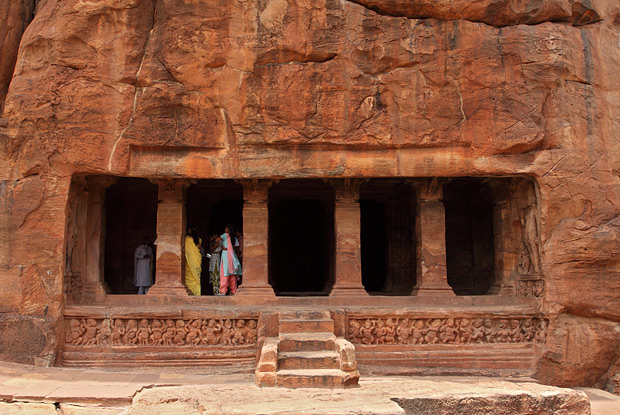
I watched the macaques climb down the cliff and carefully sneak behind people as I waited for a guide to be available. They were not always stealthy; when they found someone visibly vulnerable, they simply snarled and openly looted what they desired. In the thirty minutes of wait for the ASI guide, I had seen a footwear stolen, a bag nearly snatched and a bunch of crossanda flowers pulled out from a lady’s braids.
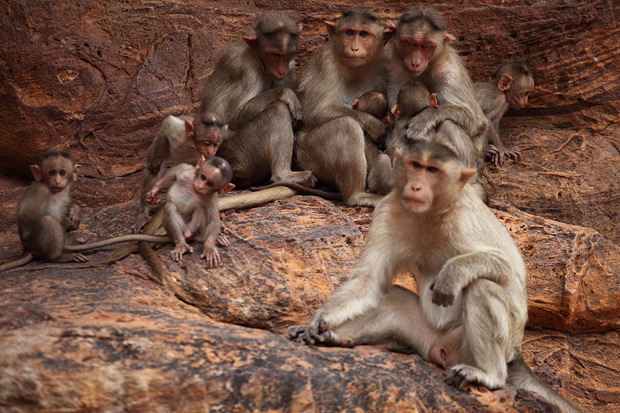
My guide Chandru was knowledgeable and articulative. He stood in dance positions and held his hands in mudras as he described how the 18-handed statue of nataraja can form 91 mudras by choosing any one of the left hands in combination with any one of the right hand.
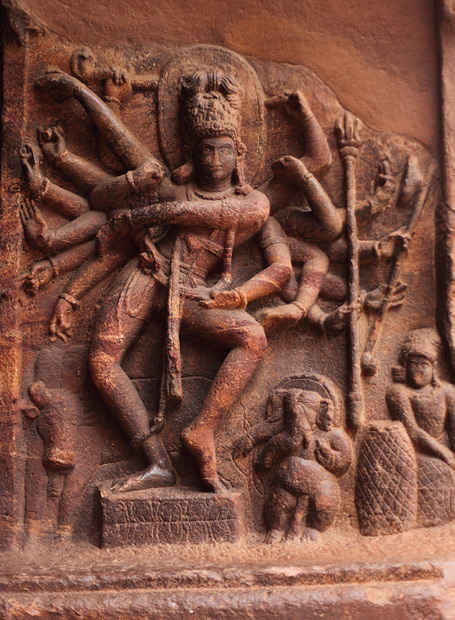
There are four cave temples in Badami with three dedicated to Vedic gods. The fourth one is a Jain Temple. The first three temples have some elaborate sandstone carvings of Hindu Pantheon such as Vamana stepping over Bali, dancing Nataraja, Varaha carrying Bhudevi and Vishnu seated on Vasuki. The Jain temple, smallest of the four has a series of Tirthankaras carved along the walls.
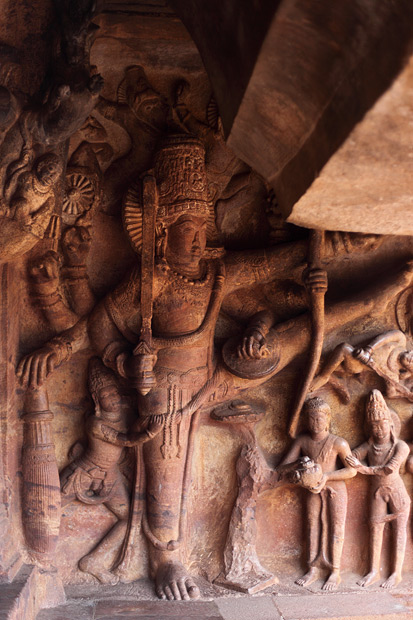
We moved through caves as Chandru described the iconography and architecture, but my questions to him were mostly related to history. The inscriptions in Badami and surrounding areas are a key to rediscovering most of the Chalukyan history. An inscription carved somewhere high up the rocks on the cliff opposite to the caves describes the times of the first Chalukyan Kings. Another inscription by Pallava King Narasimhavarman I informs of the brief occupation of Badami by Pallavas, while one in faraway Kanchi’s Kailasanath temple inscribed by Chalukya Vikramaditya II indicates the reversal of fortune for Pallavas. A detailed inscription on a pillar in nearby Mahakoota Village, carved in the time of king Mangalesha, provides much needed information about the lineage of Chalukyas and the spread of their kingdom. An inscriptions in Aihole Village describe the victory of Pulikeshi II over Harshavardhana and another one gives vague clues about the time period of poet Kalidasa.
The early Chalukyas ruled Badami from 6th to 8th century before the region was annexed by Rashtrakutas. In 12th century, Rashtrakutas were overpowered by later Chalukyas, whose lineage from the earlier Chalukya Kings is still debated. Badami was later ruled by Hoysala Kings, Vijayanagar Dynasty, Adil Shahis from Bijapur, Tipu Sultan and the British.
Who would think of the small town of Badami to be an ideal place to establish a kingdom and rule most of the peninsula? Chalukya Kings did, and they thought so more than 1,500 years ago. They constructed a large tank in a depression surrounded by sandstone cliffs in three sides, carved a few temples in those cliffs, built some more temples on the top and established the center of a dynasty that ruled for 600 years to control most of the land between Narmada and Kaveri.
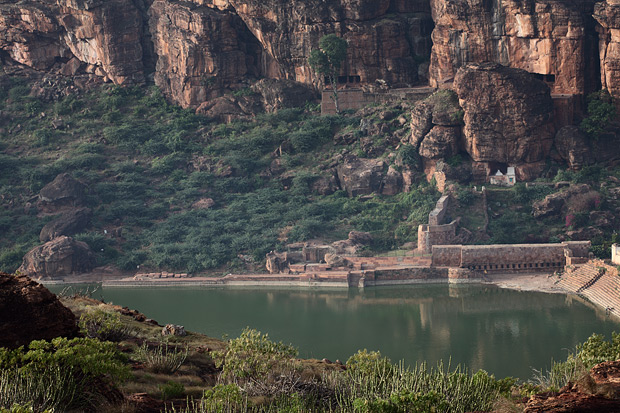
If recorded history of Badami is interesting, the associated legend is fascinating. On his journey south of Vindhyas, Sage Agastya was invited by demon Ilvala for a meal. Ilvala and his brother Vatapi called guests home and killed them in the most innovative possible way. Vatapi would turn into a ram while Ilvala would cook the ram’s meat and offer it to the guests. Once eaten, Vatapi would come out splitting the stomach of the guest, thus killing him.
But when it comes to legends, sages are always smarter than demons. Agastya knew the whole plan and digested Vatapi before he could come out, putting an end to the evils of the pair. The two cliffs around the lake in Badami are believed to be the two dead demons who were defeated by Sage Agastya.
The legend would have brought some aura to the town, but it is the remains of history that brings in bus loads of tourists today. My bus took me here on a relatively dry monsoon day, taking me through the vast plains of North Karnataka. Later half of my journey was largely sleepless, thanks to roadhumps that defied the logic of having a road at all. Beyond the stout hills past Hospet where river Tungabhadra overflowed and glittered in the moonlight, it was a perfectly flat terrain hosting groundnut fields, free of even slightest aberration anywhere in my field of vision. Arrival of Badami was marked by a change in landscape as the moonlight over the plains gave way to sun shining on vertical cliffs of red sandstone.
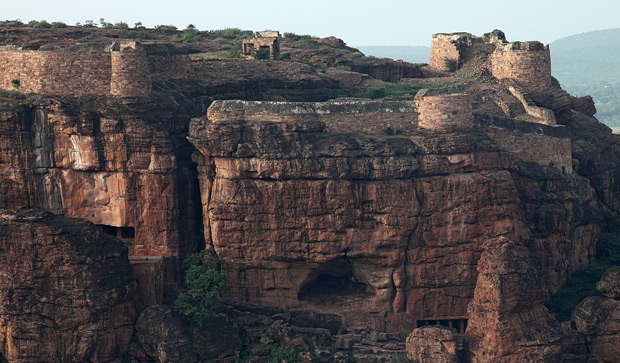
This was my second visit to Badami. I was here two years ago in a winter when the sky was blue and air was dry. But having seen tourist brochures of foaming water rushing down the red cliffs, I wanted to be here when it rained, when the vertical rock faces were wet and dripping. This time I had arrived in in the middle of the monsoon season and the sky stayed overcast through the four days I spent in the town. But rain gods remained unwilling to let down even a drop of water from those heavy clouds. Save for a gentle drizzle or two that gave me some hope, the weather remained dry and dusty. A few months after my visit, the clouds would descend with such a fury in and around the town that thousands of people were rendered homeless and that year’s effort in the groundnut fields were washed away by the raging floods.
How much ever I would have preferred to see it raining, it did not disappoint me to an extent that I would get out soon. I spent next four days walking around the tank, exploring the cliffs and the table land above them, visiting the villages nearby and a few curious rock structures near the town.
I made a quick visit to Coorg last weekend, driving past some well known and some less known places in the hilly district. I was there on work,designing a story telling tour on the nature, history and culture of Coorg for TravelWise. Most of the time was spent talking to a few home-stay owners, checking out road conditions and measuring time taken to travel from place to place. I had seen most of these places during my half-a-dozen or so visits to Coorg earlier, except for Omkareshwar Temple and the tombs of the kings. Also, I was going there now after having gone through a lot of material on history, nature and culture of Coorg.
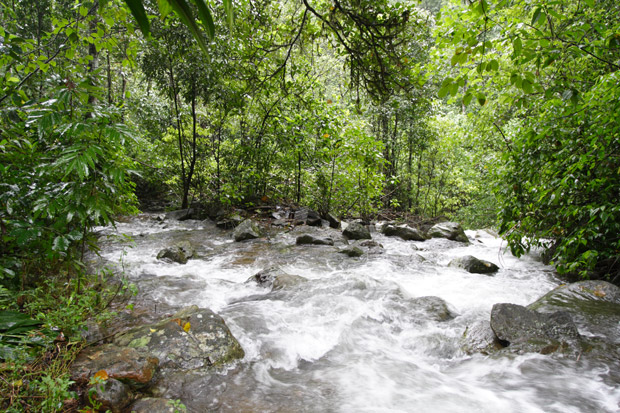
File photo of a stream passing through a private land. Picture from one of the places we visited last weekend.
I was instantly captured by the beauty of the Omkareshwar Temple with its large kalyani and the indo-sarcenic architecture. The temple premises were very quiet and there were just a handful of people besides us. It is located in a quieter corner of Madikeri where there is little traffic and very few tourists coming in.
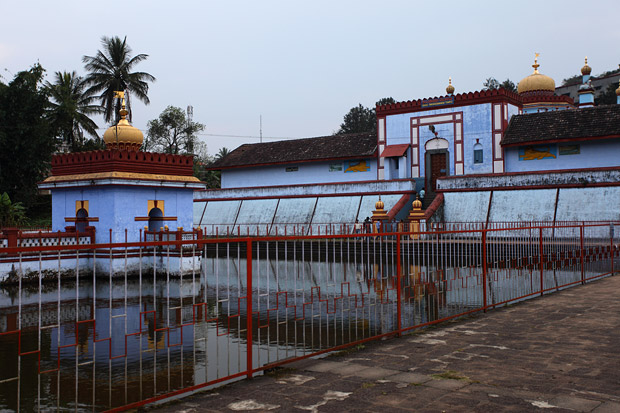
Omkareshwar Temple, Madikeri
Gaddige is an array of tombs of the kings of Coorg – Dodda Veeraraja, Lingarajendra and a few courtiers. Located on a small hillock in a grassy plain, the tombs look grand and beautiful from outside, though the interiors are plain and simple.
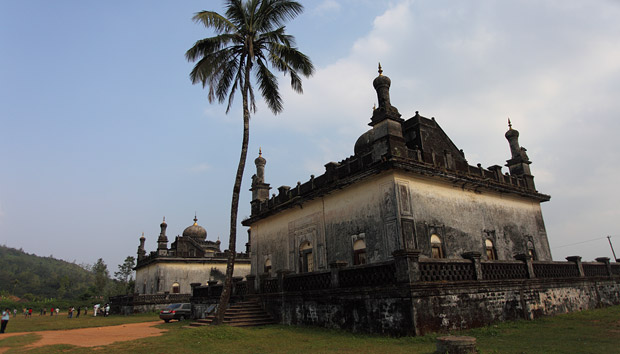
Gaddige or the Tombs of the Kings in Madikeri
Some of the other things we are working on for the tour are possible short nature walks, visit to Talakaveri and Bhagamandala, insights to growing coffee in Coorg, insights to the distinct culture of Kodavas with a visit to their ancestral house and a few more things. We also met a well informed and well travelled Kodava who gave us a lot of dope on the culture and history of Coorg, told us of the less known stories of Igguthappa and about an ancient trading route to Kerala through the hills. Of course we saw some of the best of the nature in Coorg, seeing a very tall waterfall in a private land and passing through coffee estates into a small meadow to the views of Kabbe Hill and the ridges around Thadiyandamol.
It was a quick visit, but well worth the journey.
Also see:
I will be posting a few more details on the upcoming trail in Coorg.







